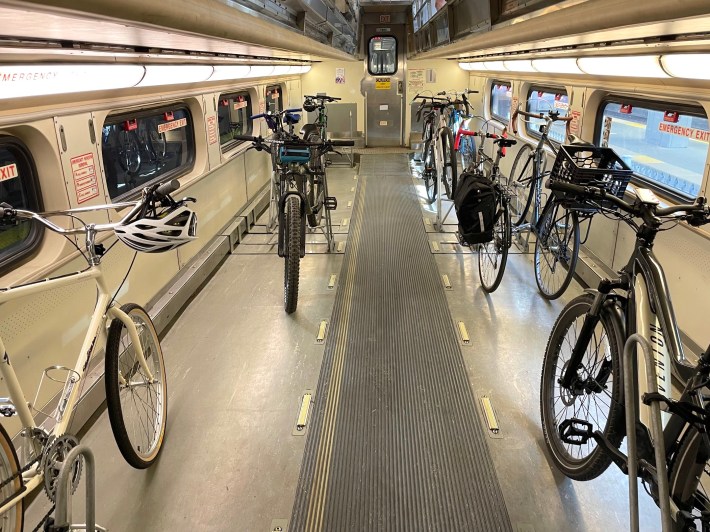
Metra announced recently that it will make its COVID-era policy of allowing bikes on all trains permanent. The commuter railroad also added that it will add more space for bike parking by installing bike racks on 50 cars for starters. The policy goes into effect this Thursday, February 1.
This change comes after Metra recorded the highest number of bike trips made using the system. According to Metra, 260,000 bicyclists took trips on the system in 2023, which the organization says is higher than pre-pandemic years. However, before COVID, bicyclists were only able to bring bikes on during non-rush periods, and had to keep their cycles in the ADA seating areas.

Opening the system up to bicycles at all times
In addition to higher ridership by bicyclists, Metra said that it is making the changes thanks to continued lobbying and input from bicycle advocates. In November, Metra formed its Community Bike Working Group and held a special information session to discuss this policy change and to engage directly with bike advocates and commuters. The creation of the group and special sessions was done thanks in part to the efforts of Michael Metz and the grassroots transit advocacy group Commuters Take Action.
In this month’s announcement about the permanent bike policy change, Metra CEO and Executive Director Jim Derwinksi specifically mentioned the efforts from bicycle advocates. "We are truly grateful to the passionate cyclists who helped us change our policy for the betterment of all riders. Metra and bicycles are natural partners, and it is gratifying to solidify our relationship," he said.

While Metra has allowed bikes on trains since 2005, they were only permitted in the ADA area of train cars, and bicycle riders were turned away at stations if too many bikes were already on board. While the new policy remains first-come-first-served — and people with disabilities will be given priority for this seating — Metra’s new policy includes the statement that "every effort will be made to accommodate customers elsewhere on the train before requiring that they leave."
However, the 50 train cars that will be getting the new bike racks will have room for upwards of four bicycles, including e-bikes and e-scooters. However, there are some rules about the type of bikes and scooters Metra will allow. For instance, bicycles cannot exceed 80 inches long and 30 inches wide, customers with bikes and scooters must be at least 16 years old, and gas-powered bikes and scooters are entirely prohibited.

Permanent bike policy comes along with new fare changes
In addition to the new bike policy and addition of bike racks, Metra’s new fare and zone system also goes into effect on Thursday. The new fare policy was approved back in November.
One of the biggest changes will be the reduction of the previous 10-zone system into just four zones. Downtown stations will be in Zone 1, while Chicago neighborhoods and immediate inner-ring suburbs are Zone 2. Outer-ring suburbs will fall into zones 3 and 4.
One-way tickets for riders traveling between the Loop and Fare Zone 2, as well as anywhere between Fare Zones 2-4, will cost $3.75. Tickets between zones 1-3 will be $5.50, while fares between zones 1-4 will cost $6.75. Metra is also discontinuing its $100 Super Saver system-wide monthly pass in exchange for a zone-based monthly pass.
More details on the fare changes, including maps, fare charts, and more, can be found on Metra’s website. Metra has also been hosting informational sessions to prepare riders for the new changes.

Did you appreciate this post? Please consider making a tax-deductible donation to help Streetsblog Chicago keep publishing through 2025. Thank you.






